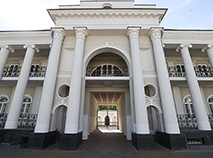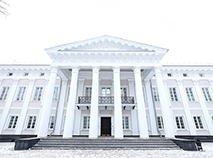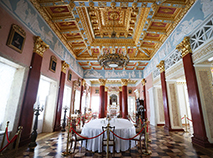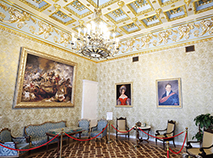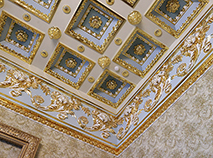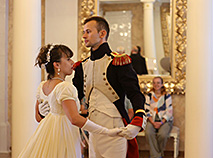Bulhak Palace in Zhilichi
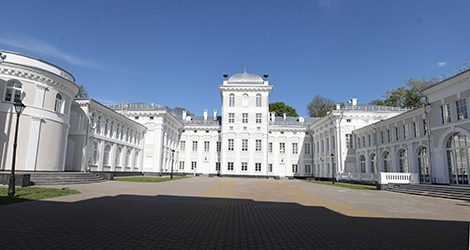
The residence in Zhilichi, which belonged to the noble family of Bulhaks, is often called "the second Nesvizh" or even "the Belarusian Versailles". The classical palace and park of the 19th century is an architectural gem of the eastern part of Belarus. This is one of the largest and best preserved estates in the country.
A magnificent ensemble near Bobruisk was built by Bobruisk District Marshal Ignatius Bulhak, the owner of the local estate of Dobosna. During the war with Napoleon, he reached Paris with the Russian army and, as they say, was so impressed by the palaces in France that he decided to build an equally splendid palazzo in his hometown. Indeed, in terms of decorative design, the palace in Zhilichi could be compared with both the French ones and the Nesvizh residence of the Radziwills, the most powerful dynasty in the Belarusian lands.
History of the Bulhak Palace in Dobosna
The wide-branched Bulhak family has been known since the 15th century and is considered one of the oldest in the Belarusian lands. A legend has it that they were related to Knight Syrokomla. In 1399, the brave warrior received a coat of arms from Jahajla and Vitaut for defeating the Khan's mirza in a personal duel during the Battle of the Vorskla River. Therefore, the Bulhaks, like many other families, used the Syrokomla coat of arms.

Since the 16th century, representatives of the Bulhak family held prominent positions in the Grand Duchy of Litva (Lithuania), and then in the Russian Empire, owned lands in Grodno, Minsk, Mogilev and other provinces.
The town of Zhilichi on the Dobosna River near Bobruisk has been known since the 15th century. At different times, it belonged to the princely families of Trabsky, Gashtold, Chodkiewicz and Sapieha. In the 17th century, a fortress was built here: earth ramparts were as high as 3 to 4 human heights and have partially survived to this day.
At the end of the 18thcentury, Ignatius Bulhak, the head of the uezd nobility, together with his brother Vincent-Nikolay, bought the Dobosna estate from Frantiszek Sapieha. The brothers left no heirs, so the estate was bequeathed to his sister Fortunata and her husband Gabriel Bulhak, who came from the parallel genealogical branch. This marriage, registered in 1785, united the Bulhak family. Later, the property and capital of the family were inherited by their son – Ignatius-Kazimir Bulhak. It was he who started a large construction in Zhilichi!

It is important to note that the Bulhaks were not as influential as the Radziwills or Sapiehas, but they were known as very successful entrepreneurs, landlords, owners of sugar and starch mills, distilleries, flouring-mills and sawmills... Therefore, the palace, the construction of which was launched in 1823, was supposed to embody dreams and impressions of France by Ignatius-Kazimir Bulhak and to demonstrate the wealth of the family.
After retiring from the army, Ignatius Bulhak married Isabella Slizeń, a girl from a rich and noble family that had no heirs in the male line. A few years later, she died leaving behind a son and a daughter. She also started a palace park and a greenhouse in Zhilichi. After mourning for his wife, Ignatius married her younger sister Teresa, thereby preserving the rights to the inheritance of the Slizeń family. The second wife was a good mother to the children of her deceased sister. She also gave birth to seven more children. So a large close-knit family needed a large palace.
The project of the palace in Zhilichi commissioned by Ignatius Bulhak was made by the famous architect, professor of the University of Vilna Karol Podczaszyński.

During the lifetime of Ignatius Bulhak, the main building was built and the side buildings were started, but the owner did not live to see the palace completed. He died in 1848. The construction was completed by his youngest son Edgar Bulhak. Already in the second half of the 19th century, the palace acquired the shape of a regular quadrangle with a large internal space.
The residence in Zhilichi was designed in Classicism style known for clean lines, clarity and simplicity of silhouette, Ionic columns, porticoes with refined stucco, rounded arches...
The palace had about a hundred rooms: banquet halls and ballrooms, many living rooms and saloons, galleries, a house chapel, a greenhouse. The chambers were located in a certain order, which is also one of the features of classicism.
The interiors were splendid: elegant ceiling stucco, expensive furniture and carpets, artistic parquet floors made of different types of wood (even with 3D effects!). Without a doubt, many of the rooms were designed to display the impressive collections of the owners for guests to see.

The Bulhaks often traveled and brought with them many artworks, entire architectural elements to decorate the estate. The ceremonial hall had paintings with the seal of the Hermitage. There were rare antique sculptures brought from Greece and Italy.
In Zhilichi one could see a collection of medieval weapons, a library of 7,000 copies of early printed and handwritten books, paintings by famous artists, including Jan Damel, an outstanding painter of the 19th century. The Bulhaks’ collection featured many ancient tapestries from the Slizeń family, 30 ornates (Catholic priests' vestments) and 18 Slutsk sashes from the Jan Madjarski Manufactory, of which the most valuable one was the sash with the inscription ‘Radziwill’. Aubusson fabrics were used for upholstery and furniture in the palace. Urechye glass, silver from Augsburg artisans, French and Italian mantel clocks made from gilded bronze, mirrors, decorative porcelain and majolica, painted vases – the palace was filled with beautiful items!

The most majestic halls of the palace are the ballroom and the banquet hall where we can still see authentic coffered ceilings of the finest workmanship. They are decorated with drawings, unique bas-reliefs, stucco moldings, and gold leaf. The ceilings show scenes from ancient, biblical, Oriental and Slavic mythology. There is hardly any artisan in the world today who could reproduce such complex decor.
It is noteworthy that, contrary to traditional designs, the ballroom in Zhilichi was arranged not on the first, but on the second floor. This allowed increasing the height of the ceiling, arranging galleries, choirs and orchestral balconies for better acoustics. By the way, the Bulhaks once had their own court composer. A maestro named Gruner, who studied in Vienna, lived in Zhilichi for about 30 years. He composed music for balls, taught music to the Bulhak children and local peasants who played at receptions.

The Bulhaks were Catholics, so no wonder they put in so much effort in styling a house chapel that looked magnificent and extremely elegant. Fragments of stucco with images of cherubs, tiled floors, pseudo-coffered ceilings have preserved to this day...
The special pride of the mansion was the greenhouse that was laid by Ignatius’s first wife Isabella. The building was designed in Warsaw and was meant for exotic tropical plants: palm trees, cypresses, lemon, orange and peach trees, even pineapples that were said to be rented out to those who wanted to impress their guests or show off... The greenhouse has not survived to this day, but now it is being restored using old photos and archival documents.

The 16-meter high tower-belvedere offered a beautiful view of the park, the cascading pond, stables and the carriage house.
...The last owner of the palace in Zhilichi was Emanuel Bulhak, the nephew of the childless bachelor Edgar Bulhak. However, the nephew did not inherit the mansion, but had to buy it. A family story tells that Edgar Bulhak was offended by his nephew’s inappropriate gift in the form of... a marble sarcophagus.

Emanuel Bulhak was a famous theologian and teacher, founder of a church and a school in Warsaw that bears his name. The heir to the family lived in Poland, rarely visiting Zhilichi Palace. When the First World War erupted, he moved all the most valuable items to the city of Orel away from the frontline, but after the Russian Revolution of 1917 he could not retrieve the treasures. In the 1920s and 1930s, many items of the collection were sold to Western art collectors.
The park ensemble in Zhilichi was nationalized after 1917. At first, an orphanage opened here, and in the 1930s the building housed a veterinary vocational school.
During the Second World War, some walls were demolished and dismantled into bricks. The Germans set up a hospital in the palace, and even buried their soldiers in the courtyard (their remains were later reburied). But the most amazing thing is that the palace survived two world wars almost intact – it was never bombed or caught fire.

After the war, an agricultural technology school opened on its premises; later the building was used as an agricultural vocational school for many decades. Of course, this had its toll on the interiors: a significant part of the decoration did not survive or was covered with layers of paint for many years.
In 1953, the palace was placed under state protection as a monument of history and culture.
Around 1971, a children's music school opened in the palace. In 1976, a museum was unveiled there; part of its collections was dedicated to the history of the estate. Some restoration works were carried out during Soviet times, but the return of the Bulhak Palace to its former glory began in 2009.
Zhilichi Palace today

In the 1910s, the mansion was visited by Jan Bulhak, who later became famous as an artistic landscape photographer. He took a number of photos of the palace and its interiors before the outbreak of the First World War and other historical events. Subsequently, these images turned out to be very useful during restoration works.
The first stage of the major restoration effort was completed in 2011. The wings of the palace and park complex became home to a children's art school, a museum and a library.
After the large-scale restoration, the palace reopened for visitors in 2023. Although even during the restoration, tourists were allowed inside.

The exterior and interior of the palace have been recreated thanks to photographs from the 1910s, old notes and sketches, and archives. The search for new exhibits continues. Today the chambers are decorated with antique furniture – purchased from collectors or loaned by them. Zhilichi also displays valuable paintings and engravings from the collections of the National Art Museum of Belarus.
The interior of the palace chapel has been carefully restored based on surviving photographs. Its altar has been decorated with a rarity acquired by the museum – The Ascension of Our Lady masterpiece, painted at the end of the 18th century and belonging to the school of Rubens.
The Zhilichi Historical Complex Museum is a popular destination for numerous visitors from Belarus and abroad. Excursions are held every hour on weekdays and every half hour on weekends.

Address: 5 Mir Street, Zhilichi agrotown, Kirovsk District, Mogilev Oblast.
Working hours: 9:00 - 18:00 (lunch break 13:00 - 14:00). The museum is closed on Mondays and Tuesdays.
The greenhouse, which was once the pride of the Bulhaks, is currently under restoration. Exotic plants are again in bloom: the project based on the archival descriptions of 1909 was prepared by the specialists of the Botanical Garden of the National Academy of Sciences of Belarus.
The former carriage house and other outbuildings, as well as the palace park with its alleys, labyrinths of paths, cascade of ponds and fountains will make the next stage of the restoration effort.
Verasneuski Fest: Palace Festival in Zhilichi

With the biggest stage of restoration over now, the ensemble is fully open to visitors. Now the Zhilichi Historical Complex Museum offers various excursions and numerous creative events every season of the year.
The regional festival Verasneuski Fest. Palace in Zhilichi (September Fest. Palace in Zhilichi) is surely to become an autumn tradition. The festival was first held to celebrate the 200th anniversary of Bulhak Palace in September 2023.
How to get there and where to stay
The agro-town Zhilichi is located in Kirovsk District, Mogilev Oblast. It is about 190km away from Minsk. The route takes the highway E271/M5 almost to Bobruisk, then the roads R93, N10457, N10451 to Zhilichi.
It is about 25km from Kirovsk, the center of the district, to Zhilichi, and about 110km from Mogilev.
You can stay in hotels in Bobruisk, Minsk or Mogilev, and there is a small hotel in Kirovsk.
What to see near the palace in Zhilichi
Today the Bulhak Palace is a part of one of the most popular tourist routes in eastern Belarus: Bobruisk – Zhilichi – Krasny Bereg. This “triangle” unites two beautiful estates, unique landmarks of military history, a town with a rich past and a colorful atmosphere.

Bobruisk is known as the “Jewish capital of Belarus” with its special charm of a place where wealthy merchants used to do business and build original mansions, where future famous personalities of religion, culture, and politics were born and grew up... Bobruisk Fortress, the “big sister” of Brest Fortress, was built here. It entered the history of the War of 1812, the Decembrist movement and the Great Patriotic War.

Krasny Bereg is famous for the Koziell Poklewski Estate, one of the most extraordinary country estates in Belarus. The bizarre palace united almost a dozen different styles - Gothic and Romanesque, Rococo and Mannerism, Baroque and Classicism, even Neo-Mauritanian style, which is not found anywhere else in the country....The symbol of the tragedy of Krasny Bereg and the whole Belarus is the memorial to the children victims of war. It was built on the site of a children's concentration camp set up by the Nazis to draw blood for German soldiers during the Great Patriotic War.

Some 45km north of Zhilichi there is the memorial complex In Memory of the Burnt Villages of Mogilev Oblast in the village of Borki, Kirovsk District. One of the largest punitive operations against civilians of Belarus took place here on 15 June 1942. More than 2,000 people - residents of Borki and surrounding villages – were killed in one day. These events, as well as the tragedy of Khatyn, and also hundreds of other burned villages in Belarus, made an underlying storyline of Elem Klimov’s film Come and See. The film makes the lists of the best war films of world cinema.
Not far from Borki and 50km away from Bulhak Palace in Zhilichi is Chigirinskoye Water Reservoir, a tourist pearl of Mogilev Oblast, the venue of the Big Bard Music & Fishing Festival. Every summer the festival brings together performers from CIS and other countries, numerous tourists. The area provides conditions for active recreation activities.








 print version
print version make home page
make home page add to bookmarks
add to bookmarks